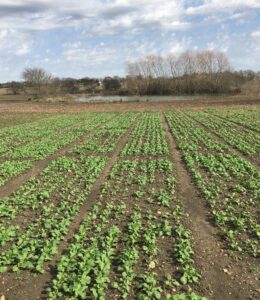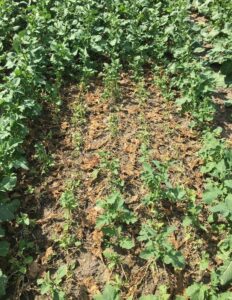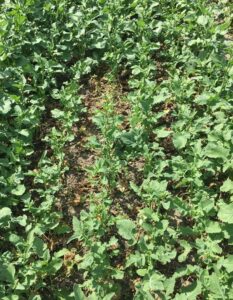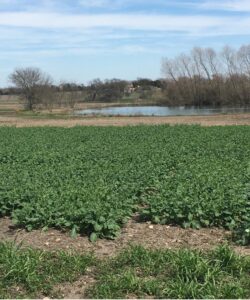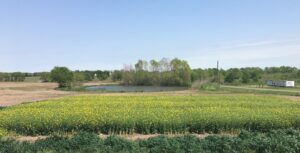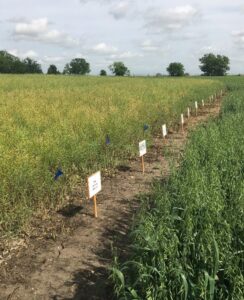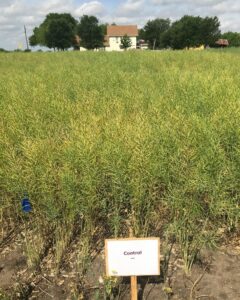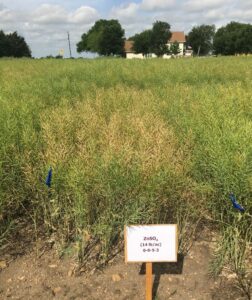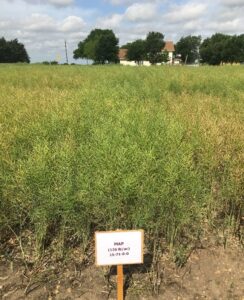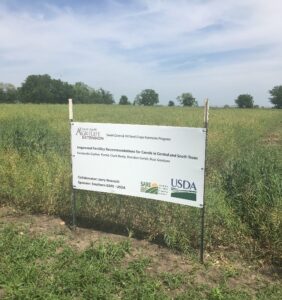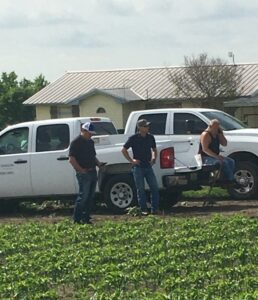Final report for OS18-119
Project Information
Winter wheat production in Texas has been in decline in recent years due to fluctuations in the agricultural commodity market. Incorporation of canola as a rotational crop in cropping systems involving wheat would diversify the farm operation, enhance crop sustainability by shortening the fallow periods, rotate herbicide chemistry, and break disease and pest cycles of wheat. Field research in canola indicates the crop has adaptability to the growing conditions in Central Texas, where grain yields above 2,000 lb ac-1 can be attained. However, further agronomic research on canola is required for the identification and adoption of the best management practices for this crop. A critical aspect for the success of canola production in Texas relates to rapid plant establishment. Furrow application of monoammonium phosphate (MAP) and diammonium phosphate (DAP) have proven to positively contribute to early growth and good stand establishment. The objective of this on-farm research study was to determine best in-furrow rates for starter MAP and DAP fertilizer that maximize economic returns for canola in a representative site of the Blacklands region.
A field study was implemented near Perry in Central Texas in which spring canola ‘CP9978F’was evaluated under the furrow application, at planting, of 14 fertilizer treatments plus one control arranged in a randomized complete block design with four replications. Fertilizer treatments consisted of different rates of MAP and DAP fertilizers with and without the addition of ZnSO4.
A cold front that went across Texas in early February 2020 affected the crop by delaying its early growth, and excess soil moisture during maturity significantly and negatively impacted yield performance and grain quality. Although no response in grain yield to the fertilizer application was observed, freeze damage, maturity, and test weight showed significant variation. Freeze damage was accentuated under treatments 136 MAP, 91 MAP, 45 MAP, and 28 DAP. It is inferred this was the result of an increased vegetative tissue under these treatments which were exposed to freezing temperatures. Control plants and those under ZnSO4 treatment matured early and yielded relatively low, suggesting these conditions provided inadequate soil nutrients available for proper development of the crop. The crop under the MAP fertilizer treatments tended to mature relatively late but also yielded low, which was probably the result of a reduced phosphorus mobilization in the soil after the initial stages of growth, the freeze damage observed during early growth and the excess soil moisture during the grain filling stage, which in turn caused lodging and seed shatter, or by a combination of all.
Freeze damage during early growth and excessive moisture during the late phase of crop development had a detrimental influence on the response of canola to the application of band fertilizer in this study, causing a confounding effect driven by changes in plant density and delayed crop maturity.
This project aims to increase sustainability by promoting the adoption of canola, a potential rotational crop for the Blacklands Region of Texas, which if successful would shorten fallow periods in wheat rotations, and improve weed control through better chemical rotation. By focusing on fertility, this study will determine best in-furrow rates for starter fertilizer that maximize economic returns for canola, and reduce residual nutrients in the soil, lowering risk of off-site movement into waterways.
Cooperators
- (Educator)
Research
A field study was implemented at a farm near Perry, TX (31⁰25’13’’ N, 96⁰54’39.6’’ W) in the Blacklands Region of Texas in a fallow, no-till Wilson silty clay loam soil. Pre-plant soil analysis indicated this field had a pH of 6.7, 107 lb ac-1 N, 71 lb ac-1 P, and 599 lb ac-1 K in the top 30 cm of soil. Climatic conditions in this area of the Blacklands are characterized for being prevalently warm and humid during the growing season. Spring canola variety ‘CP9978F’, a glyphosate resistant spring variety with good agronomic performance in the Great Plains, was planted on December 9, 2020, with a Hege 500 (Hege Co. Waldenburg, Germany) single cone, double-disk plot drill, using a seeding rate equivalent to 465,000 seeds ac-1 on plots 5 ft. wide and 30 ft. long.
The experiment consisted of the application of in-furrow fertilizer treatments arranged in a randomized complete block design with four replications, where a plot constituted the experimental unit. Fertilizer treatments consisted of 14 different N-P-Zn-S rates applied at the time of planting plus one with no fertilizer application to be used as control (Table 1). Treatments corresponded with the monoammonium phosphate (MAP) and diammonium phosphate (DAP) formulas such that each product was applied at three N rates: 5, 10, and 15 lb ac-1 N, which corresponded with 3 and 5 phosphorus rates per N rate applied, respectively. Also, every MAP and DAP treatment occurred with and without the application of ZnSO4 applied at 14 lb a-1. In addition, DAP was also applied at a rate of 139 lb a-1, which represents approximately 1/3 of total N required, corresponding with current fall N and P fertilizer recommendations for a crop expected to yield 1,500 lb a-1. During the planting process seed and fertilizer mix were emptied separately into the drill for each plot to prevent seed fertilizer contact.
Table 1. Description of fertilizer treatments used in the agronomic evaluation of Spring Canola near Perry, TX in 2020-2021.
|
Treatment |
Nitrogen |
P2O5 |
Zinc |
Sulfur |
Product |
|
|
------------------- (lb a-1) ------------------- |
|
|||
|
1 |
5 |
23 |
0 |
0 |
45 lb MAP |
|
2 |
10 |
47 |
0 |
0 |
91 lb MAP |
|
3 |
15 |
71 |
0 |
0 |
136 lb MAP |
|
4 |
5 |
13 |
0 |
0 |
28 lb DAP |
|
5 |
10 |
26 |
0 |
0 |
56 lb DAP |
|
6 |
15 |
39 |
0 |
0 |
84 lb DAP |
|
7 |
5 |
23 |
5 |
2.6 |
45 lb MAP+14 lb ZnSO4 |
|
8 |
10 |
47 |
5 |
2.6 |
91 lb MAP+14 lb ZnSO4 |
|
9 |
15 |
71 |
5 |
2.6 |
136 lb MAP+14 lb ZnSO4 |
|
10 |
5 |
13 |
5 |
2.6 |
28 lb DAP+14 lb ZnSO4 |
|
11 |
10 |
26 |
5 |
2.6 |
56 lb DAP+14 lb ZnSO4 |
|
12 |
15 |
39 |
5 |
2.6 |
84 lb DAP+14 lb ZnSO4 |
|
13 |
0 |
0 |
5 |
2.6 |
14 lb ZnSO4 |
|
14 |
25 |
64 |
0 |
0 |
139 lb DAP |
|
15 |
0 |
0 |
0 |
0 |
0 |
On February 3, 2021, glyphosate (Roundup PowerMax) was applied at an equivalent rate of 32 oz ac-1 for the control of henbit (Lamium amplexicaule). Stand notes were taken approximately 48 days after planting using a scale from 1 to 9 (1=extremely poor plot cover, 9=complete plot cover), freeze damage notes were taken on February 25, 2021, approximately 10 days after winter snowstorm Uri impacted the area, using a scale from 1 to 9 (1=no damage, 9=plants burned down). Flowering notes were collected as the number of days at which 50% of the plants in the experimental unit reached full flowering. On May 31, 2020, 173 days after planting, maturity notes were collected using a scale from 1 to 9 (1=very early, 9=very late). The study was harvested on June 12, 2021, 195 days after planting. Lodging notes were collected prior to harvest using a scale from 1 to 9 (1=no lodging at all, 9=complete lodging).
On May 26, 2021, a field day was implemented at the site of the study. Falls County Extension agent Pasquale Swaner was invited to join the initiative and to assist in the process of reaching out to local producers in Falls County and neighboring counties as well. The overall purpose of the activity was to explain local producers in the area the importance of crop rotations to achieve high crop productivity, to introduce those unfamiliar with canola to the crop, to provide a brief overview of management practices of canola production and the importance of availability of soil nutrients during early growth for rapid plant establishment and growth, key features for optimum production in canola. The collaborator of this study, producer Jerry Nowaski, was asked to provide a brief overview on his experience on canola and on his view about the importance of the study for canola production in Central Texas. I prepared a brief overview on canola production in Central Texas and central management issues needed attention for effective production of the crop, specifically on the aspect concerning identification of best management practices conducive to optimum growth during the establishment phase of the crop.
Plots were harvested on June 12, 2021, with a Wintersteiger (Wintersteiger Ag. Ried, Austria) plot combine. The harvested seed was dried at 95oF for three days in an oven drier and then run for test weight and moisture content, protein content, and seed oil concentration. Test weight and grain moisture were determined with a Dickie-John GAC 2100 (Churchill Industries, Minneapolis) Agri Bench grain moisture tester machine, grain protein was determined with a Foss Infratec 1226 (Foss Analytical, Denmark) Grain Analyzer instrument, and oil content with a Perten DA 7250 NIR (Perkin Elmer, Massachusetts) instrument. The data collected was subjected to standard statistical analysis using SAS 9.4 (SAS Institute, Cary, NC) in which the PROC GLM procedure was used to test the effects in the linear model, the LSMEANS procedure was used for estimation of means, and the LSD procedure was used for mean separation purposes.
Temperature and precipitation conditions during the growing season at the site of the study are shown in Figure 1. During mid-February, approximately 66 days after planting, winter storm Uri brought extreme low temperatures to the area (11⁰F). As a result of that, the average temperature in February 2021 was only 47⁰F. This unprecedented cold front delayed the growth of canola and had an indirect impact on the performance of the crop, as we will see later. Also, starting approximately at the second week of May, 2021 (about 120 days after planting) seasonal precipitation became incessantly intense in the area and did not stop until the end of the season, time in which the cumulative precipitation reached about 1250 mm (49 inches). This relentless rain affected the seed maturation process and caused significant lodging across treatments, lowered grain test weight, and presumably caused seed loss due to seed shattering.
Figure 1. Temperature conditions and total cumulative precipitation during the 2020-2021 growing season observed at Perry, TX. Data compiled for the period November 1, 2020 through June 30, 2021. (Grassland Soil and Water Research Laboratory, Riesel Climatic Data)
Agronomic response
Despite the humid, warmer conditions observed throughout the growing season in the area, no diseases or pests affected the crop. No significant response in grain yield or seed quality attributes to the application of fertilizer was observed in the study (Table 2). However, freeze damage, maturity, and test weight showed significant variation. Photos 1 – 11 provide a graphic description of the study. Increased freeze damage was observed in canola under treatments 136 MAP, 91 MAP, 45 MAP, and 28 DAP (scale values of 3, 2, 1.8, and 1.8, respectively), suggesting that plants grown under these treatments developed greater biomass, in which the negative effect of cold temperatures was more pronounced. In a study involving the banding application of, among others, MAP and DAP fertilizers, Thomas and Rengel (2002) found increased early growth of canola under the application of these fertilizers, although the response was greater under the DAP fertilizer. If that was the case in this study, subsequent growth of plants under these treatments after the freezing front of early February might have been significantly delayed.
Plants under the control and under treatment ZnSO4 showed a relative early maturity (scale values of 4.3 and 4.8), whereas plants under treatments 136 MAP, 91 MAP, 139 MAP, and 136 MAP + ZnSO4 were late in maturity (scale values of 7.5, 7.3, 7.3, and 7.3). This disagrees with previous research that indicates that lack of available phosphorus in the soil can delay the maturity of canola (Canola Encyclopedia, 2021). It is possible that the observed delay in maturity in plants under these MAP treatments was the result of the freezing temperatures observed during early growth. Average test weight was relatively low across all treatments, with an overall mean value of only 44.4 lb Bu-1. plants under treatments 28 DAP, 84 DAP + ZnSO4, and ZnSO4 developed grain with relative high test weight (46 lb Bu-1 whereas plants under treatment 136 MAP with low test weight (41.8 lb Bu-1).
A significant correlation between stand and maturity (r = -0.53), stand and grain yield (r = -0.81), freeze damage and maturity (r = 0.52), freeze damage and test weight (r = -0.74), and maturity and test weight (r = =-0.59) was found (Table 3, Figure 2). This strongly suggests that the freeze damage caused by snowstorm Uri in mid February significantly delayed the maturity of the canola, which in turn caused a negative correspondence between stand and maturity and between stand and grain yield. Freeze damage and maturity altogether significantly and negatively affected test weight as well. Given that a significant variation in maturity among the treatments was observed, it was considered pertinent to further assess the effect of this trait on grain yield. A regression analysis of maturity on grain yield suggested a quadratic response (Figure 3). As it was already pointed out, relative early maturity was observed under the control and treatment 14 ZnSO4, and late maturity under treatments 136 MAP, 136 MAP + ZnSO4, 91 MAP, and 139 MAP. The observed low yields under the control and treatment 14 ZnSO4 might have been the result of inadequate soil nutrient available for proper development of the crop. There is no clear explanation for the observed low yields under the MAP fertilizer treatments. It could have been the consequence of reduced mobilization and availability of phosphorus after the early growth phase, it could have been caused by the freeze damage observed during early growth and by excess soil moisture during the grain filling stage, which in turn caused lodging and seed shatter, or by a combination of both.
Considering all this it is plausible that freeze damage during early growth and excessive moisture during maturity were central events in the observed response of canola to the application of fertilizer, causing a confounding effect driven by altering plant density and delaying maturity.
Field day
A Field day was planned and it was implemented on April 26, 2021 at the site of the study (Appendix, Photos 13 – 15). Despite the promotional effort made by Mr. Pasquale Swaner, Falls County Extension Agent, no producer attendance was received at the event. The collaborator of this on-farm research study, producer Jerry Nowaski, made the comment that attendance to field days in his area is highly likely if they are implemented using county extension units (CEU). Unfortunately, no CEUs were involved for the implementation of this event. It is also likely that the lack of response may have been due to COVID 19.
Table 2. Mean values and standard statistics parameters for major agronomic characteristics in spring canola variety ‘CP9978F’ subjected to the furrow application of 14 fertilizer treatments (plus control) at planting in Perry, TX, 2021.
|
No |
Treatment |
Nitrogen |
P2O5 |
Zinc |
Sulfur |
Stand note |
Freeze damage |
Lodging note |
Maturity note |
Grain yield |
Test weight |
Protein conc. |
Oil content |
|
scale |
scale |
scale |
scale |
lb/ac |
lb/Bu |
% |
% |
||||||
|
1 |
45 MAP |
5 |
23 |
0 |
0 |
7.5 |
1.8 |
9.0 |
5.5 |
696.9 |
43.1 |
21.5 |
41.3 |
|
2 |
91 MAP |
10 |
47 |
0 |
0 |
6.8 |
2.0 |
9.0 |
7.3 |
732.4 |
43.8 |
21.5 |
40.4 |
|
3 |
136 MAP |
15 |
71 |
0 |
0 |
7.5 |
3.0 |
9.0 |
7.5 |
528.8 |
41.8 |
21.9 |
40.6 |
|
4 |
28 DAP |
5 |
13 |
0 |
0 |
7.3 |
1.8 |
9.0 |
5.0 |
739.2 |
45.7 |
22.1 |
40.6 |
|
5 |
56 DAP |
10 |
26 |
0 |
0 |
7.0 |
1.3 |
9.0 |
6.0 |
691.1 |
45.0 |
21.6 |
41.1 |
|
6 |
84 DAP |
15 |
39 |
0 |
0 |
7.0 |
1.3 |
9.0 |
6.3 |
824.6 |
44.1 |
22.1 |
41.1 |
|
7 |
45 MAP + 14 ZnS |
5 |
23 |
5 |
2.6 |
6.5 |
1.0 |
9.0 |
6.8 |
729.9 |
44.1 |
22.0 |
40.8 |
|
8 |
91 MAP + 14 ZnS |
10 |
47 |
5 |
2.6 |
7.0 |
1.5 |
9.0 |
6.5 |
840.2 |
43.9 |
21.7 |
40.8 |
|
9 |
136 MAP + 14 ZnS |
15 |
71 |
5 |
2.6 |
7.5 |
1.5 |
9.0 |
7.3 |
622.4 |
43.7 |
22.0 |
41.3 |
|
10 |
28 DAP + 14 ZnS |
5 |
13 |
5 |
2.6 |
7.3 |
1.0 |
9.0 |
5.0 |
617.3 |
44.6 |
22.2 |
40.8 |
|
11 |
56 DAP + 14 ZnS |
10 |
26 |
5 |
2.6 |
6.8 |
1.0 |
9.0 |
6.0 |
896.0 |
45.0 |
21.8 |
40.4 |
|
12 |
84 DAP + 14 ZnS |
15 |
39 |
5 |
2.6 |
6.8 |
1.0 |
9.0 |
5.8 |
914.4 |
45.7 |
22.0 |
40.6 |
|
13 |
14 ZnS |
0 |
0 |
5 |
2.6 |
7.8 |
1.0 |
9.0 |
4.8 |
442.5 |
45.5 |
21.8 |
40.5 |
|
14 |
139 DAP |
25 |
64 |
0 |
0 |
6.8 |
1.5 |
9.0 |
7.3 |
793.5 |
45.0 |
21.9 |
40.5 |
|
15 |
Control |
0 |
0 |
0 |
0 |
8.0 |
1.0 |
9.0 |
4.3 |
490.6 |
45.1 |
22.2 |
40.3 |
|
Mean |
7.2 |
1.4 |
9.0 |
6.1 |
704.0 |
44.4 |
21.9 |
40.7 |
|||||
|
Pr > F |
NS |
* |
-- |
** |
NS |
* |
NS |
NS |
|||||
|
LSD (0.05) |
-- |
1.1 |
-- |
1.7 |
-- |
2.1 |
-- |
-- |
|||||
|
CV (%) |
11 |
55 |
-- |
20 |
34 |
3 |
2 |
2 |
|||||
*, Significant at the 0.05 probability level.
Table 3. Simple (Pearson) correlation coefficients among response variables in spring canola variety ‘CP9978F’ subjected to the furrow application of 14 fertilizer treatments (plus control) at planting in Perry, TX, 2021.
|
Stand |
Freeze damage |
Maturity |
Grain yield |
Test weight |
Protein conc. |
Oil content |
|
|
|
scale |
scale |
scale |
Lb ac-1 |
Lb Bu-1 |
% |
% |
|
Stand |
1.00 |
0.13 |
-0.53* |
-0.81*** |
-0.08 |
0.21 |
0.01 |
|
Freeze damage |
1.00 |
0.52* |
-0.18 |
-0.74** |
-0.31 |
0.05 |
|
|
Maturity |
1.00 |
0.29 |
-0.59* |
-0.31 |
0.17 |
||
|
Grain yield |
1.00 |
0.20 |
-0.15 |
0.07 |
|||
|
Test weight |
1.00 |
0.29 |
-0.36 |
||||
|
Protein conc. |
1.00 |
-0.16 |
|||||
|
Oil content |
1.00 |
*, **, *** Significant at the 0.05, 0.01, and 0.001 probability levels.
Figure 2. Scatter plots among variables in spring canola variety ‘CP9978F’ subjected to the furrow application of 14 fertilizer treatments (plus control) at planting in Perry, TX, 2021.
Figure 3. Effect of maturity on grain yield in spring canola variety ‘CP9978F’ subjected to the furrow application of 14 fertilizer treatments (plus control) at planting in Perry, TX, 2021.
Conclusions
No response in grain yield and grain quality to the fertilizer application was observed in this study. It is likely that the response was greatly affected by climatic events observed during early growth and crop maturity. For instance, the freeze damage caused by a snowstorm early in February 2021 was accentuated under treatments 136 MAP, 91 MAP, 45 MAP, and 28 DAP, which appeared to be the result of increased vegetative tissue exposed to freezing temperatures. Excessive and relentless rains during the seed filling stage delayed the maturity of the crop, causing severe lodging and negatively affecting test weight. Under these drastic growing conditions, plants that grew in absence of DAP or MAP fertilizer appeared to have inadequate soil nutrients available for proper development and were also negatively affected by those climatic events; and those that grew with the application of fertilizer were negatively impacted by both climatic events.
Considering all this it is plausible that freeze damage during early growth and excessive moisture during maturity were central events in the observed response of canola to the application of fertilizer, causing a confounding effect driven by altering plant density and delaying maturity.
Photo Gallery
Photo 1. Early growth
Photo 2. Freeze damage
Photo 3. Freeze damage
Photo 4. Vegetative growth
Photo 5. Flowering
Photo 6. Grain filling
Photo 7. Relative maturity (Control)
Photo 8. Relative maturity (Treatment ZnSO4)
Photo 9. Relative maturity (MAP, 136 lb ac-1)
Educational & Outreach Activities
Participation Summary:
A Field day was planned and it was implemented on April 26, 2021 at the site of the study. Despite the promotional effort made by Mr. Pasquale Swaner, Falls County Extension Agent, no producer attendance was received at the event. The collaborator of this on-farm research study, producer Jerry Nowaski, made the comment that attendance to field days in his area is highly likely if they are implemented using county extension units (CEU). Unfortunately, no CEUs were involved for the implementation of this event. It is also likely that the lack of response may have been due to COVID 19.
A technical report of this study was posted on our website (http://varietytesting.tamu.edu/cool-season-oilseeds/).
Photo 10. Field day
Photo 11. Field day
Learning Outcomes
Project Outcomes
In this study, the response of canola to the application of starter fertilizer at planting was affected by an unprecedented cold front in early February, 2021, that brought freezing temperatures that lasted for days in a row, and by relentless rains in the last phase of the crop. As a result of that, it was not possible to precisely determine the level of response of canola to in-furrow fertilizer application. Nevertheless, this study provided valid insights in regard to the levels of freeze damage in spring canola 'CP9978F' in Central Texas and its impact in productivity.



